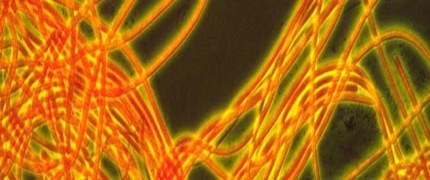NASA

© 2008 Ellesmere Ice Shelves
Microbial ecosystems
The majority of life on Earth, both in biomass and numbers, is microbial. Microbes are the basis of the Arctic food web and moderate biogeochemical cycles, but their diversity and ecosystem functioning are only now being explored. During the last IPY (in 1957) it was impossible to study microbes because the technologies were not available, but with innovative molecular tools, such as DNA sequencing, the first ever comprehensive survey of Arctic microbiology is being conducted. The survey comes none too soon, as climate related changes in the Arctic are resulting in the disappearance of rare habitats harbouring novel microbial ecosystems.
The surface of ice shelves and the underlying water column are habitat for cold-tolerant microbial communities. Study of these organisms provides insight into the environmental limits of life on Earth, the evolution of life during glacial episodes, and provides analogues for possibility of life existing elsewhere in the solar system, such as on Jupiter’s ice covered moon Europa.
The Canadian program of the IPY project MERGE (Microbiological and Ecological Responses to Global Environmental change in the polar regions) is focused on change in aquatic ecosystems in the Arctic and their surrounding catchments, with an emphasis on the biodiversity of their microscopic life. The Ellesmere Island ice shelves and glacial fiords are undergoing dramatic changes; the break-up of the Ward Hunt Ice Shelf drained a previously ice-dammed epishelf lake in Disraeli Fiord. The loss of this rare ecosystem is of critical concern, as the waters of many of these high-Arctic fiords are poorly studied. Our team will collect aquatic DNA samples to analyze the microbiological biodiversity and the community structure of these unique habitats while they still exist. This study will provide a snapshot of the current aquatic microbial ecosystem at a time of significant environmental change and will also provide a baseline comparison for future studies.
Research Summary
The project will focus on the biodiversity and distribution of aquatic microbial communities in the ice-covered fiords along the NW coast of Ellesmere Island. The physical characteristics of the water column will be analyzed by CTD (conductivity, temperature, and depth) profiles in several fiords. Microbiological DNA samples will be collected at multiple depths. We expect to sample a number of highly stratified ice-dammed lakes and will collect samples from the freshwater surface layer, the brackish interface layer, and the deep saltwater layer. Ice-conditions permitting, we will also collect marine microbial samples off-shore of the ice shelves. Microbial samples will be size-fractionated (a >3 µm fraction and a 0.2-3 µm fraction) and preserved for subsequent molecular analysis, as well as preserve water samples for microscopy to determine plankton taxonomic identity and biomass.
For more information in microbial communities in the Arctic please visit the IPY MERGE website by clicking the logo in the column to the left.
Principal Investigators
Dr. Warwick Vincent (Lead) Université Laval
Dr. Connie Lovejoy Université Laval
Dr. Isabelle Laurion INRS-ETE
Researcher
Andrew Hamilton M.Sc. Université Laval
Fluorescence micrograph of the filamentous cyanobacteria (order Oscillatoriales) that often dominate the benthic mats in Arctic lakes and streams. Courtesy of the MERGE website.


